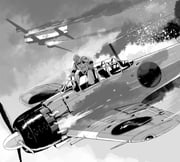a6m zero
The Mitsubishi A6M was the primary carrier-based fighter aircraft operated by the Imperial Japanese Navy during World War II. Its long designation was "Type 0 Carrier Fighter" (零式艦上戦闘機), and it was commonly called "Reisen" (零戦, zero fighter) by its pilots. This nickname was also popular among the Allies, more so than the official reporting name "Zeke". The plane was designed by Horikoshi Jirou.
When the ZERO was first introduced in 1940 it was considered the most capable carrier-based fighter, combining excellent maneuverability with a good climb rate and a very long operational range. These qualities combined with the excellent training of IJN pilots allowed the Japanese to win numerous early victories over their Allied adversaries. Because of its attributes the Zero was instrumental in the success of the attack at Pearl Harbor.
However, after the Americans introduced the F6F Hellcat and F4U Corsair in 1942, both of which are much faster, have longer operational range, and are more resilient and have better armor than the Zero, it began to struggle to compete against both planes, particularly due to its weak airframe and being particularily vulnerable to boom-and-zoom tactics. In the later half of the war, with the loss of experienced IJN pilots, the Zero were mostly assigned as suicidal kamikaze aircraft in a desperate attempt to defend the country of Japan.
See also
- Sakai Saburou - greatest Zero fighter ace ever.
- Kaze Tachinu
- Cosmo Zero
- A6M2-N
- Ki-43 Hayabusa - similar aircraft in terms of appearance and performance
- List of airplanes








